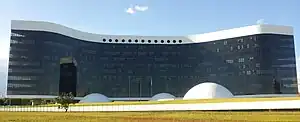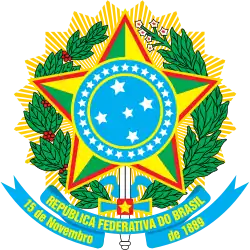Superior Electoral Court
The Superior Electoral Court (Brazilian Portuguese: Tribunal Superior Eleitoral, TSE) is the highest body of the Brazilian Electoral Justice, which also comprises one Regional Electoral Court (Brazilian Portuguese: Tribunal Regional Eleitoral, TRE) in each of the 26 states and the Federal District of the country, as determined by the Article 118 of the Constitution of Brazil.[1]
| Superior Electoral Court | |
|---|---|
| Tribunal Superior Eleitoral | |
 | |
 The Superior Electoral Court building in Brasília | |
| 15°48′37″S 47°52′18″W | |
| Established | 24 February 1932 |
| Location | Brasília, Brazil |
| Coordinates | 15°48′37″S 47°52′18″W |
| Composition method | Election among members of the Supreme Federal Court and Superior Court of Justice |
| Authorized by | Constitution of Brazil |
| Appeals from | Regional Electoral Courts |
| Judge term length | Two years, renewable once consecutively |
| Number of positions | 7 |
| Website | www |
| President | |
| Currently | Alexandre de Moraes |
| Since | 16 August 2022 |
| Vice President | |
| Currently | Cármen Lúcia |
| Since | 25 May 2023 |
Background and legal provisions
The Brazilian Electoral Code of 1932 established the Electoral Justice in Brazil, replacing the political system conducted by the Legislative branch over the electoral proceedings.[2] The new judicial system transferred control over such proceedings to the Judiciary. In the present, duties of the Electoral Justice are regulated by a posterior Electoral Code, approved in 1965 (Law No. 4.737/65),[3] which revoked the 1932 code, but kept the judicial control over the electoral proceedings.
The Superior Electoral Court is the highest judicial body of the Brazilian Electoral Justice as per the §3 of the Article 121 of the Brazilian Constitution of 1988, which sets that the decisions of the TSE are unappealable, except those contrary to the Constitution, or that deny habeas corpus or writs of mandamus. Therefore, in such exceptions, the Supreme Federal Court (STF) judges appeals filed against the TSE's rulings.
The composition of the TSE is ruled by the Article 119 of the Constitution of Brazil, which sets that the court shall be composed by seven members. Three of them shall be elected by secret vote from among the Justices of the STF and two other judges shall be elected by secret vote from among the Justices of the Superior Court of Justice (STJ). The remaining two shall be appointed by the President of Brazil from among six lawyers of notable juridical knowledge, and good moral reputation, nominated by the STF.
Current composition
| This article is part of a series on the |
 |
|---|
| Name | Origin | Function |
|---|---|---|
| Effective Justices | ||
| Alexandre de Moraes | STF | President |
| Cármen Lúcia | STF | Vice President |
| Nunes Marques | STF | |
| Raul Araújo | STJ | |
| Benedito Gonçalves | STJ | Inspector |
| Floriano Marques Neto | Jurist | |
| André Ramos Tavares | Jurist | |
| Substitute Justices | ||
| Gilmar Mendes | STF | |
| Dias Toffoli | STF | |
| André Mendonça | STF | |
| Isabel Gallotti | STJ | |
| Antônio Carlos Ferreira | STJ | |
| Vacant | Jurist | |
| Edilene Lôbo | Jurist | |
In relation to other courts
| [4][5][6] | State | Federal | ||
|---|---|---|---|---|
| Superior courts |
0 | Supreme Federal Court STF |
1 | |
| Federal superior courts | 4 | |||
| Common justice |
Court of Justice TJ |
27 | Federal Regional Courts TRF1 .. TRF6 |
6 |
| Specialized justice |
State Military Justice Courts |
3 | Electoral Justice Courts TRE |
27 |
| TJME | Regional Labor Courts TRT |
24 | ||
| Total |
30 | 62 | ||
References
- "University of Minnesota Human Rights Library". hrlibrary.umn.edu. Retrieved 4 July 2023.
- SILVA, José Afonso da. Curso de Direito Constitucional Positivo. 33ª Ed. São Paulo: Malheiros, 2009.
- MARTINS, Flavia Bahia. Direito constitucional. 2ª Ed. Niterói: Impetus, 2011.
- "O Brasil tem 91 tribunais - Para Entender Direito" [Brazil has 91 courts - Understand the Law]. Folha de S. Paulo (in Portuguese). 20 October 2010. Archived from the original on 3 September 2015.
- DataSelf (8 January 2021). "Conheça as diferenças e funções dos tribunais brasileiros" [Know the differences and functions of the Brazilian courts] (in Portuguese). DataSelf. Retrieved 28 June 2023.
- Conselho Nacional de Justiça. "Tribunais - Portal CNJ" [Courts - CNJ Portal]. National Council of Justice (in Portuguese). Retrieved 28 June 2023.